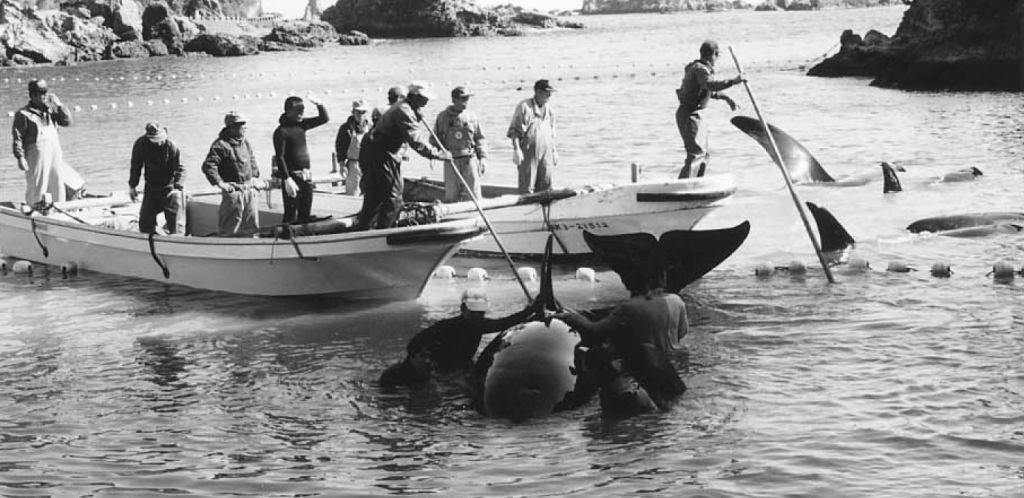
Who were they?
- Unnamed male – 4 months in captivity
- Unnamed female – 4 months in captivity
- Kyu – 7 years in captivity
- Asuka – 10 years in captivity
- Ku – 11 years in captivity
Their story:
In 1991 five Japanese aquariums submitted permit applications to the National Fisheries Agency to capture wild killer whales under the guise of scientific research. Following review, the permits were approved and five killer whales were permitted to be captured every year from 1993 onwards for “research” purposes.
After years of no sightings, fishermen from the Isana Fishermen’s Union spotted a pod of 10 transient killer whales travelling 50km off the Japanese coast on February 7th, 1997. They quickly set out in eight boats to drive the whales towards Hatajiri Bay. By using water bombs and banging on iron rods to create a wall of underwater noise, the fishermen were able to coral the disorientated whales into the cove and block the bay’s entrance with a series of nets. The whales were trapped.

By February 9th, representatives from various Japanese aquaria flooded to the bay to inspect the whales. Three marine parks – Izu-Mito Sea Paradise, Shirahama Adventure World and Taiji Whale Museum – successfully bid for five of the orcas (2 males and 3 females) and were rumoured of have paid 30 million yen (~$250,000) per whale. On February 10th the purchased whales were roughly netted away from their pod members and wrestled into slings to either be lifted by crane into transport containers or wedged between two boats and carried. The shocking treatment they received and their distressed cries had been captured on video for the world to see, but public outcry failed to save them.
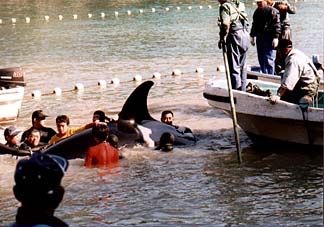
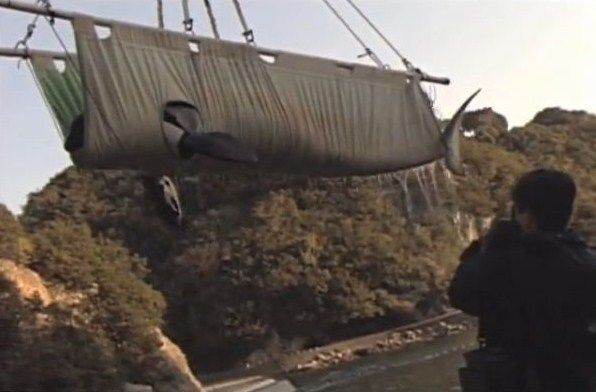
Watching the whole ordeal was the five remaining orcas (3 males and 2 females), who had been released earlier on that day to avoid violating the permit. However, while the orcas had been given the chance to leave, they stayed, unwilling to abandon their pod members.
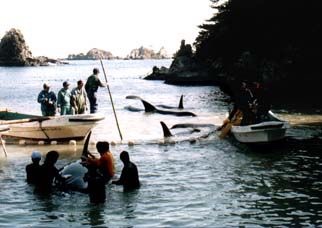
They watched as each of the purchased whales were removed from the bay, still refusing to leave. The fisherman became aggressive and began harassing the whales with the motors on their skiffs. Only as the last orca was prepared for transport were the fisherman finally able to drive the whales back to sea, with one bleeding from a wound.
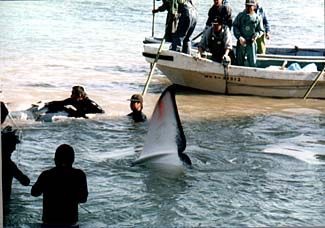
While what they had experienced was horrendous, these whales had been granted their freedom. The Taiji 5, as they became known, weren’t so lucky. They were dispatched to their buyers to live and die in concrete tanks.
- Izu-Mito Sea Paradise purchased one orca – a 5.5m female later named Asuka.
- Nanki Shirahama Adevnture World purchased three orcas – one 6.3m female and two males – one measuring 3.75m and the other 4.7m. The larger male was later named Kyu.
- Taiji Whale Museum purchased one orca – a 4.55m female later named Ku.
Alongside various Japanese animal welfare groups, world-renowned Orca researcher, Dr. Paul Spong, set off to monitor the post-capture condition of all five orcas with visits to the relevant facilities in March 1998, May 1998 and February 1999. His findings and what happened to the whales once he left Japan are detailed below:
Unnamed male
At 3.75m in length and weighing around 700kg the unnamed male was the smallest and also the youngest of the Taiji 5, believed to be just three years old. He didn’t survive long enough to receive a name. This young male appeared very sickly on the day he was captured and his health continued to deteriorate once he was transported to Nanki Shirahama Adventure World. While it’s believed he was eating during the few months he spent at the park he died suddenly on June 14th, 1997 after only 130 days in captivity. His cause of death was listed as systemic viral infection.
Unnamed female
Having also not survived long enough to receive a name, this unnamed female was believed to be pregnant at the time of her capture due to her heightened level of aggression and unusually large size. She thrashed so much during the capture process she injured herself and sustained a bleeding wound. She was sent to Nanki Shirahama Adventure World with the two younger males but while they were persuaded to eat, she refused. Trainers resulted to force-feeding her small amounts of fish – around 10kg per day – but it was barely enough to sustain her. It’s believed she suffered a miscarriage in April 1997 and by June she was so weak from malnutrition she was unable to keep herself afloat and had to be supported by a canvas sling in a half empty tank to prevent her from drowning. This is how she spent her final days before succumbing to bronchopneumonia on June 17th, 1997, after only four months in captivity.
Kyu
Out of the three whales who were sent to Nanki Shirahama Adventure World Kyu was the only one who survived long enough to receive a name. At 4.7m and 1350kg he was the largest of the Taiji 5’s males. Little is known about Kyu’s initial acclimation to captivity but it’s believed he was eating by May 1997.

When Dr. Spong visited him again in February 1999 he was confined to an 8m square tank where he had been held since his capture. He once shared this space with the unnamed male and female but when they both died in June 1997 he was left alone. The park had three other orcas (Goro, Ran and Ruka) who shared a connected 8mx15m tank but Kyu still hadn’t been introduced to them by the time of Dr. Spong’s visit. This soon changed as Kyu began performing alongside all three of his tankmates later that year, although Ruka died in 2000 leaving just three of them at the park.

Photos provided by Blue Waters.
As Kyu approached his teenage years he mated with Icelandic female Ran who gave birth to a female calf on August 26th, 2004. Unfortunately, the calf was born premature and had a broken skull leading to her death two days later. Ran died the following day from birthing complications.

Photo provided by EmilyOrca.
Kyu had lost his mate, his calf and then he lost his life less than a month later when he succumbed to bacterial pneumonia on September 18th, 2004. It’s believed Kyu also suffered from stomach ulcers and a weakened immune system, both of which can be caused by chronic stress.
Asuka:
Believed to be 7 years old at the time of her capture, Asuka was first transported to Taiji Whale Museum with another female later known as Ku before being transported to her final destination: Izu-Mito Sea Paradise.

In the month or so following her arrival Asuka prompted great concern from Dr. Spong and the team. She was not eating properly and exhibited depressions behind her blow-hole, a sign of malnutrition. Naturally consuming a diet of marine mammals, a bucket of dead, frozen fish was far from what she was used to so its unsurprising she struggled to adapt to her new diet. Fortunately, by late May she had gained some weight and was eating 50kg of fish per day.
Soon enough she was introduced to Yamato, Izu-Mito Sea Paradise’s sole performing orca. Asuka and Yamato (previously known as Tanouk) seemed to get along quite well and began performing together.

Photo provided by Kimmy Vengeance.
Izu-Mito Sea Paradise hoped the pair would breed but when Yamato died in October 2000 the plan to establish a breeding programme was abandoned and Asuka was left alone. She spent the remainder of her life performing alongside dolphins until her death on September 19th, 2007. Her cause of death remains unknown.

Ku:
Five-year-old Ku also prompted great concern. She had been transported to Taiji Whale Museum and kept in a small 10m square pen where she exhibited erratic behaviour described by Dr Spong as a “bizarre twisting movement with her body every minute or two”. But that wasn’t the only cause for concern. Upon arrival at Taiji Whale Museum Ku’s health began to deteriorate. She too struggled with a diet of frozen fish and lost a considerable amount of weight within the first few months of her confinement. To make matters worse she reportedly had several tumours that were quickly removed after being discovered. She eventually started eating 46kg of mackerel per day by May 1997 but she was left with a series of parallel ridges running across her back, behind the blowhole, that may have resulted from her skin filling out once she began gaining weight again after months of suffering from malnutrition. She remained sick for the best part of a year before she fully recovered.

By the time of Dr. Spong’s third visit Ku was in great condition. She was out of her 10m square pen and now resided in the largest part of Taiji Whale Museum’s lagoon, believed to be around 130m across. She was energetic, alert and hooked on the live fish that entered her enclosure.

She had been briefly introduced to Taiji Whale Museum’s other killer whale, a larger female named Nami, but the pair had to be separated due to their conflicting personalities. Ku was a friendly whale while Nami tended to be more aggressive – she had little tolerance for Ku’s presence. Incompatible with the museum’s only other orca, Ku then resided with two bottlenose dolphins and seemed to get along with them quite well, although she spent a lot of time facing Nami’s enclosure, perhaps craving interaction with her own species.

Photo provided by m-louis.
After six years at Taiji Whale Museum Ku was sent to Port of Nagoya Aquarium on a five-year breeding loan. She was trained for artificial insemination in hope that she would become pregnant. However, Ku disliked the procedure and plans to breed her were abandoned. Instead, she became the star attraction at the aquarium and performed alongside dolphins in daily shows.
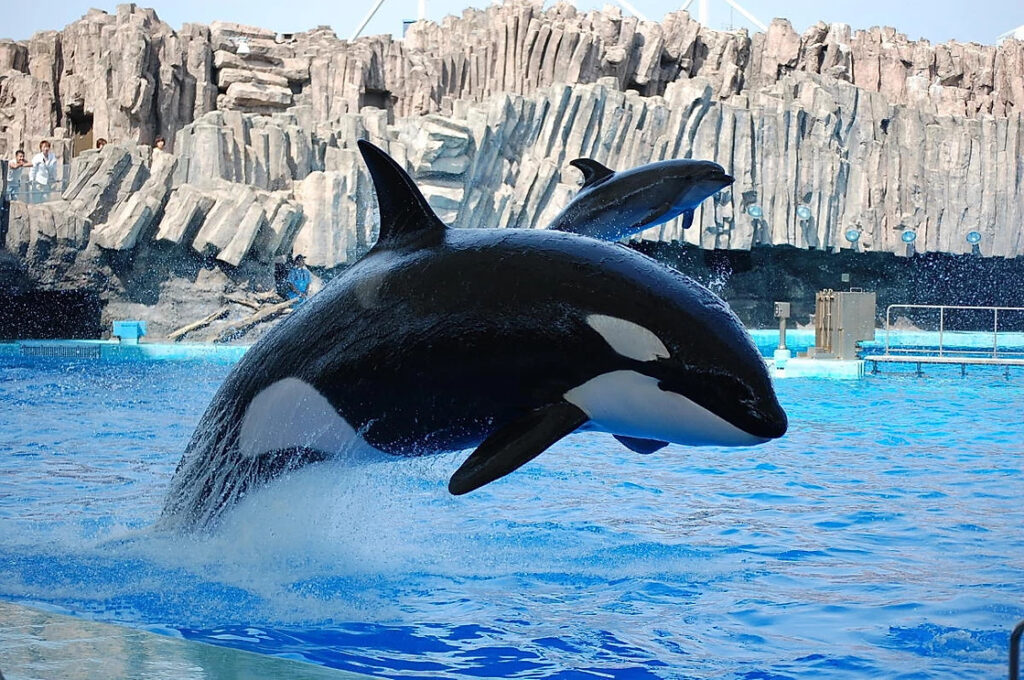
However, despite being described as a friendly whale, Ku lashed out at a trainer during a performance in the mid-2000s. She lunged forward with her mouth open as her trainer reached down into a bucket of fish. Fortunately, the trainer was uninjured.
Ku’s behaviour goes to show the toll captivity can have on killer whales. One roaming free, she was then limited to Taiji Whale Museum’s lagoon and further limited to Port of Nagoya Aquarium’s concrete tanks which were completely devoid of the environmental stimulation Ku once experienced at the museum (e.g. waves, plants and sand), including the live fish she once fixated on in her sea pen. It’s unsurprising Ku lashed out at those who deprived her of so much.
In July 2008 Ku’s health began to deteriorate and she refused to eat. She was moved to the medical pool and, with round-the-clock care, slowly began to get better. In August she appeared to have fully recovered but just over a month later, on September 19th, 2008, Ku was found dead at the bottom of her tank due to apparent heart failure. She had contracted a Herpes virus that weakened her immune system. Her previous battle with an undisclosed illness put a massive amount of strain on her heart leading to her tragic death.
Ku was the last surviving member of the Taiji 5. Her death marked the complete eradication of five young orcas captured and exploited for sake of human greed…
Additional photos:
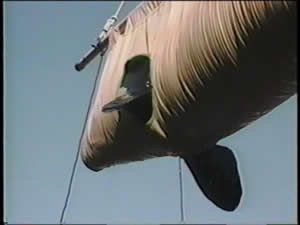
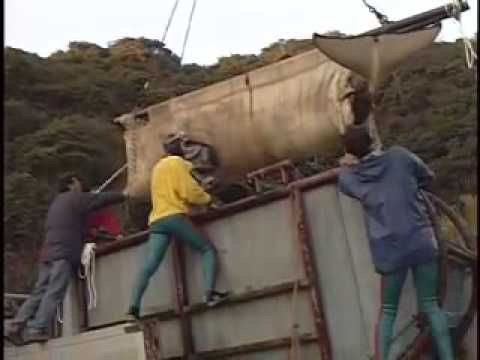
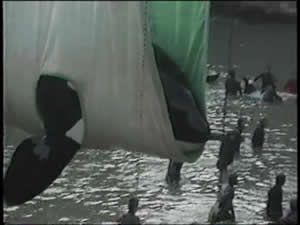
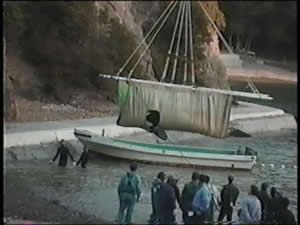
Footage:
Sources:
“Remembering the Taiji 5” by The Dolphin Project
“Dying to Entertain You” by Whale and Dolphin Conservation Society (WDCS)